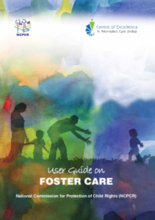Displaying 1351 - 1360 of 2214
This article is based on research about children in long-term care. It focuses on the factors that help and hinder a child being and feeling stable in their foster home and having a sense of permanence.
This paper draws attention to a small sample of policy approaches and developments in meeting the needs of oung people leaving care settings in certain jurisdictions.
This book draws on archival, oral history and public policy sources to tell a history of foster care in Australia from the nineteenth century to the present day.
This User Guide aims to provide a comprehensive approach to the development of a good quality foster care service in India, which will be useful for a range of practitioners.
This Plan presents key findings and 23 recommendations, sub-divided into short-term, medium-term and long-term actions, for an effective and efficient implementation of foster care, adoption and family support in Cambodia.
This exploratory paper’s purpose is to determine the effect of demographic, risk, and protective factors on social-emotional development, as measured by the Ages and Stages Questionnaire Social Emotional (ASQ:SE), in children age 8 months to 5 years in out-of-home care in Ontario, Canada.
It is well documented that children placed in out-of-home care in Denmark perform poorly on a wide range of short-term and long-term outcomes compared to other children. This paper describes the core components of an innovative project that will attempt to address some of the major weaknesses of previous interventions and which, if successful, will be rolled out across foster care families nationwide.
This article from Children's Legal Rights Journal discusses the statistics and data regarding foster youth who are commercially exploited for sex, and examines the various reasons why foster care children represent such a large proportion of the victims.
‘Prepare for Leaving Care – A Child Protection System that Works for Professionals and Young People’, a two-year project co-funded by the Rights, Equality and Citizenship (REC) Programme of the European Union (2017-2018), aims to ensure that the rights of young people in alternative care are respected and that they are prepared for an independent life.
The goal of the research is to gain insight into the challenges of foster care for children with behavioral problems from the perspective of experts and their suggestions for improving foster care, with the purpose of identifying guidelines for the development of specialized foster care and protecting the welfare of children with behavioral problems.


